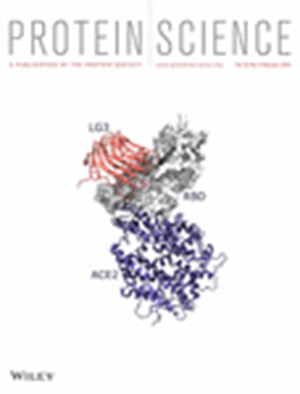Mining unique cysteine synthetases and computational study on thoroughly eliminating feedback inhibition through tunnel engineering
IF 4.5
3区 生物学
Q1 BIOCHEMISTRY & MOLECULAR BIOLOGY
引用次数: 0
Abstract
L‐cysteine is an essential component in pharmaceutical and agricultural industries, and synthetic biology has made strides in developing new metabolic pathways for its production, particularly in archaea with unique O‐phosphoserine sulfhydrylases (OPSS) as key enzymes. In this study, we employed database mining to identify a highly catalytic activity OPSS from挖掘独特的半胱氨酸合成酶,并对通过隧道工程彻底消除反馈抑制进行计算研究
L-半胱氨酸是制药业和农业的重要成分,合成生物学在开发生产L-半胱氨酸的新代谢途径方面取得了长足进步,特别是在以独特的O-磷酸丝氨酸巯基酶(OPSS)为关键酶的古细菌中。在本研究中,我们利用数据库挖掘技术从醋杆菌中鉴定出了一种高催化活性的 OPSS(AsOPSS)。然而,我们发现 AsOPSS 的酶活性受到了产物 L-半胱氨酸的显著反馈抑制,其 IC50 值仅为 1.2 mM。我们采用半合理设计结合隧道分析的策略来设计 AsOPSS。最终得到了最佳变体 AsOPSSA218R,它在不牺牲催化效率的情况下完全消除了对产物的抑制。分子对接和分子动力学模拟表明,AsOPSSA218R 与 L-cys 的结合构象发生了改变,导致 L-cysteine 与活性口袋之间的亲和力降低。隧道分析表明,AsOPSSA218R 变体重塑了隧道景观,从而构建了一个新的隧道。此外,随机加速分子动力学模拟和伞状取样模拟表明,新隧道提高了产物释放的适宜性,并有效分离了产物释放和底物结合过程之间的干扰。最后,使用 AsOPSSA218R 变体在体外 2 小时内生产出了超过 45 毫摩尔的 L-半胱氨酸。我们的发现强调了通过人工生成新的产物释放通道来缓解反馈抑制的潜力,同时也为高效生产 L-半胱氨酸奠定了酶学基础。
本文章由计算机程序翻译,如有差异,请以英文原文为准。
求助全文
约1分钟内获得全文
求助全文
来源期刊

Protein Science
生物-生化与分子生物学
CiteScore
12.40
自引率
1.20%
发文量
246
审稿时长
1 months
期刊介绍:
Protein Science, the flagship journal of The Protein Society, is a publication that focuses on advancing fundamental knowledge in the field of protein molecules. The journal welcomes original reports and review articles that contribute to our understanding of protein function, structure, folding, design, and evolution.
Additionally, Protein Science encourages papers that explore the applications of protein science in various areas such as therapeutics, protein-based biomaterials, bionanotechnology, synthetic biology, and bioelectronics.
The journal accepts manuscript submissions in any suitable format for review, with the requirement of converting the manuscript to journal-style format only upon acceptance for publication.
Protein Science is indexed and abstracted in numerous databases, including the Agricultural & Environmental Science Database (ProQuest), Biological Science Database (ProQuest), CAS: Chemical Abstracts Service (ACS), Embase (Elsevier), Health & Medical Collection (ProQuest), Health Research Premium Collection (ProQuest), Materials Science & Engineering Database (ProQuest), MEDLINE/PubMed (NLM), Natural Science Collection (ProQuest), and SciTech Premium Collection (ProQuest).
 求助内容:
求助内容: 应助结果提醒方式:
应助结果提醒方式:


